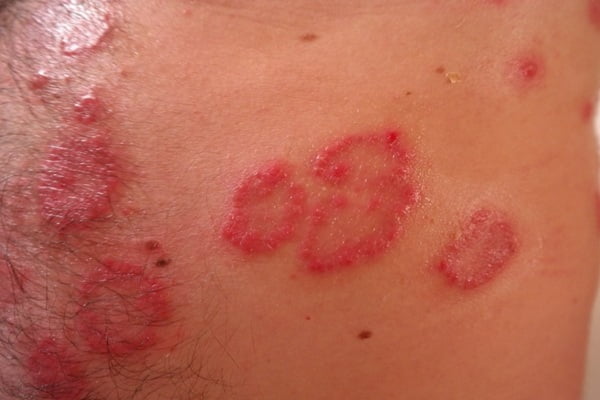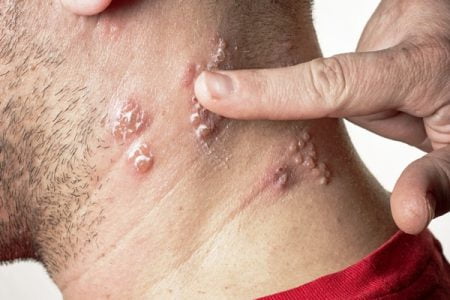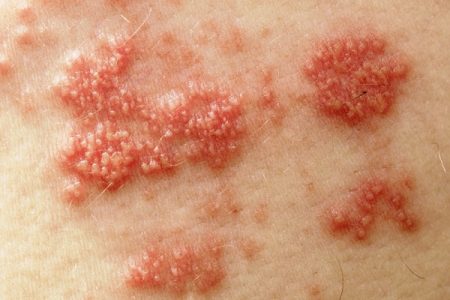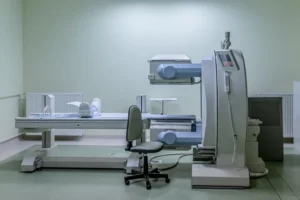Is Shingles Contagious: Who is at Risk?
- Updated on: Jul 11, 2024
- 6 min Read
- Published on Oct 3, 2019

 What Is Shingles – Definition and Overview?
What Is Shingles – Definition and Overview?
Shingles involves appearance of itchy, burning and painful rashes on your skin surface. It occurs due to reactivation of varicella- zoster virus. This virus also leads to the development of chicken pox. It usually occurs in individuals who had suffered from chickenpox in past.
Shingles usually lasts for about two to six weeks, which follows with a period of consistent pain and healing.
Shingles is extremely common; about one in three adults may suffer from shingles. A huge population is shingles contagious and is responsible for its increased transmission further.
Are Shingles Contagious? Is the Shingles Virus Contagious?
Shingles infection is in itself not contagious and does not lead to the transmission of herpes virus from one individual to another. But its causative agent, the varicella-zoster virus is contagious. When the virus gets activated and leads to the development of fluid filled blisters, it can get easily transferred to other individuals who come in its contact.
If the virus is present in an inactive state in your body, then shingles is not contagious and cannot be transmitted to other individuals.
Spreading of Herpes Virus
A person suffering from shingles can spread the varicella-zoster virus to those individuals who did not suffer from chicken pox in their lifetime or who did not take chickenpox virus before. These individuals, upon infection, can lead to the occurrence of chicken pox and not shingles.
Individuals who had suffered from chickenpox even once in their lifetime still contain antibodies against the varicella-zoster virus in their bodies. So, even if they come in contact with a shingles virus, they may not develop shingle symptoms.
After a person has had chicken pox, the herpes virus remains inactive in the nerve roots near the spinal cord or base of the facial nerve. When your immune system becomes weak or when your immunity against the herpes virus diminishes, the virus may be reactivated and may cause inflammation of the nerve. This results in the development of shingles.
Shingles leads to the development of open, oozing blisters, through which the virus gets transmitted to other individuals. It is transmitted by contacting unscabbed shingles blisters. These blisters develop along the nerve pathway on the body and are extremely painful. Shingle rashes are not contagious but can create a lot of discomfort.
More: Shingles in the Eye: Symptoms, Complications, Diagnosis and More
More: What causes shingles?
Stages of shingle virus growth
When the herpes virus reactivates in your body, you may experience a certain discomfort, a tingling-type of feeling or just a sudden twinge under your skin. You may experience these sensations on any part of the body such as waist, back, thigh, chest, face, and ear and eye area. Some individuals also experience a burning hot sensation, itching and numbness in certain body parts.
Usually, within a period of five days, shingles rash may appear on your body. These shingle rashes appear as red spots on your skin and are extremely painful. As the rashes further grow, liquid-filled blisters may develop and may ooze out. These blisters and shingle rashes continue to develop for 3-5 days. This time period is known as shingles contagious period and the herpes virus has a high potential of transmission to another individuals during this duration.
These blisters dry out and crust over to form scabs within a period of one or two weeks and then become non-contagious.
Along with the appearance of blisters, patients may experience certain flu-like symptoms such as fever, headache, fatigue, light sensitivity and malaise.
Shingles contagious period
The shingle contagious period is when the shingle rashes are in blister-phase. It is a short period when the blisters are filled with infectious fluid and ooze out from the body. During this time period, they show high transmission ability. Before appearance of the blisters and after the crusting of these blisters, the virus is no more contagious.
Modes of shingles transmission
Shingles is transmitted from oozing blisters of a shingles patient. Once the blisters become crusty scabs, the virus does not transmit and the shingles is no more infectious. The shingle virus is not contagious even when the blisters are covered.
Transmission of shingle virus is quite rare through contact with an infected person’s saliva and nasal secretion. If a shingle’s patient coughs or sneezes near you, you are less prone to get infected with shingle virus. Shingle virus is not even transmitted through a sexual contact or intercourse.
Who are at risk of getting infected with shingles virus?
An individual who has suffered from chickenpox in his/her lifetime is at high risk of getting shingles disease. When the varicella-zoster virus enters the human body for the first time; it leads to the occurrence of chickenpox. Then, it remains in a person’s body in dormant state. Whenever it gets activated, it leads to the development of shingles.
Individual of all age groups can get shingles, but it most commonly occurs in people of age group 60-70 years.
When a person’s immune system becomes weak, the virus gets activated and leads to the development of shingles. The occurrence of shingles is highest when you are sick or are extremely stressed out.
People who have a weak immune system such as a HIV patient, organ transplant recipients, people consuming immunosuppressant medication and those undergoing chemotherapy are at greater risk of getting shingles.
Early signs of shingles
The early signs and symptoms of shingles include headache, fever and chills. The most common and noticeable signs of shingles include:
Blisters
Blisters are the most noticeable symptoms of shingle, which also occur during chickenpox. Blisters involve appearance of open bumps with oozing fluid and crust over the bumps. They appear on a particular area of the body, that is, torso mostly and then spread around the waist on one side of the body. They usually develop where shingle rashes appear on your body.
If you experience blisters on one side of your face, you should consult your doctor on an urgent basis.
Pain due to shingles
The shingle virus resides in the nerves of your body and causes pain and some strange sensations. You may feel a burning sensation or a tingling feeling before the blisters may appear. Shingle patients may experience itching and sensitivity to touch.
Pain during shingles varies in severity and is quite difficult to treat with simple, over-the-counter medication. Your doctor may prescribe certain antidepressants or steroids to relive severe nerve pain.
How to avoid shingles transmission?
The varicella-zoster virus is less likely to be transmitted through a shingle’s patient than a chickenpox’s patient.
Shingle blisters are high risk sources for transmission of the shingle virus. You should take the following precautions to avoid shingle transmission:
Keep the Shingle Rash Clean and Covered
Shingles gets transmitted to other individuals when they come in contact with open oozing blisters of a shingle patient. If you keep your blisters clean and covered, people won’t come in contact with your blisters and it may be less contagious.
Wash your Hands often
You should wash your hands often and try avoiding touching and scratching your blisters. This also prevents transmission of shingle virus through infected hands.
Avoid Being around Pregnant Women
The herpes-zoster virus is highly dangerous for pregnant women and their babies. They can lead to serious health problems such as pneumonia and birth defects. A shingles patient should avoid coming in contact with a pregnant women who had not suffered from chickenpox before or had not taken its vaccine.
If you come in contact with a pregnant lady by chance, notify her immediately so that she can consult her gynecologist for further preventive measures.
Avoid People who are at Greater Risk
If your shingle blisters have been not crusted, you should avoid coming in contact with premature babies, babies who have a low birth weight or who are of less than a month in age as they are highly contagious to the herpes virus.
Children and adult, who did not have chickenpox earlier and did not take its vaccine, are also prone to the virus infection.
You should also avoid coming in contact with immunosuppressant individuals such as people who are undergoing chemotherapy, organ transplant recipients, HIV patients and those who are consuming immunosuppressant medication.
Shingle vaccine
Shingle vaccine is different from chickenpox vaccine. It prevents the occurrence of shingles and its associated widespread nerve pain. This vaccine prevents occurrence of shingles if the herpes virus is present in an inactive state in your body.
Adults who are 60+ are at greater risk for shingles. They can consult their doctors for shingles vaccine and can find out if herpes virus is present in their bodies.
Zostavax is a common shingle vaccine, which is a US FDA-approved vaccine, recommended for older adults. It is a live attenuated vaccine, which is less prone to shingles development after its administration.
When to See a Doctor for Singles Disease?
You should meet your doctor as soon as possible if you notice signs of shingles, especially in the following conditions:
- Pain and rashes near an eye. If left untreated, this infection may lead to permanent damage of your eye.
- You’re older than 50 years. Age increases the risk of developing single complications.
- If you or someone in your family has a disturbed or weak immune system such as due to cancer, certain medications or chronic illness etc.
- If the rash is painful and spread.












